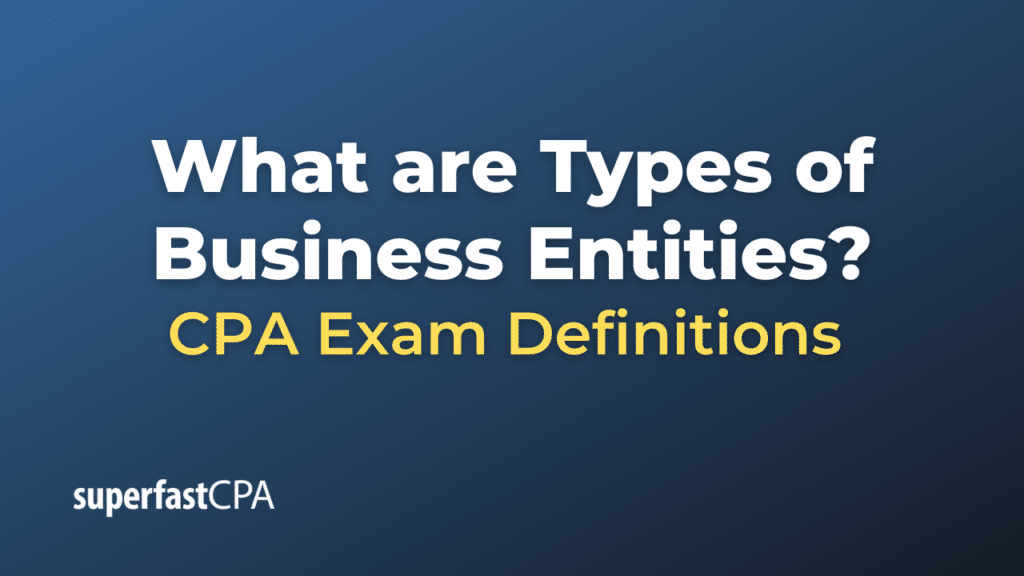Types of Business Entities
Business entities can vary based on legal structure, tax implications, liability considerations, and other factors. Different countries may have specific types of business entities or terminologies, but many concepts are similar globally. Here are some of the most common types of business entities:
- Sole Proprietorship:
- This is the simplest form of business structure, owned and operated by a single individual.
- The owner is personally responsible for all debts and obligations of the business.
- There’s no legal distinction between the owner and the business.
- Partnership:
- A business arrangement in which two or more individuals share the ownership, profits, and liabilities.
- There are different forms of partnerships, such as general partnerships (GP), limited partnerships (LP), and limited liability partnerships (LLP).
- Corporation (or Incorporated Company):
- A separate legal entity owned by shareholders.
- Shareholders are generally not personally liable for the debts of the corporation.
- There are various types of corporations, such as C-corporations, S-corporations (in the U.S.), and public and private limited companies in other jurisdictions.
- Limited Liability Company (LLC):
- Offers limited liability protection for its owners (called members), like a corporation.
- Can be taxed as a sole proprietorship, partnership, or corporation depending on the number of members and the choices made for tax treatment.
- Cooperative (or Co-op):
- Owned and operated by the people who use its services or by its employees.
- Members vote on the direction of the cooperative, and profits are distributed based on use or investment.
- Joint Venture:
- A business arrangement where two or more parties come together to undertake a specific project or business activity.
- The parties agree to share profits, losses, and control of the venture.
- Franchise:
- Allows individuals (franchisees) to operate a business using the branding, products, and services of an established company (franchisor).
- The franchisee typically pays an initial fee and ongoing royalties to the franchisor.
- Trust:
- Nonprofit Organization (or Not-for-Profit):
- Operates for charitable, educational, religious, or other purposes that serve the public interest.
- Profits are not distributed to owners or shareholders but are used to pursue the organization’s objectives.
- Professional Corporation (PC):
- Used by professionals such as doctors, lawyers, accountants, and architects.
- Offers some liability protection but often with certain restrictions or regulations.
- Limited Partnership (LP):
- Consists of general partners who manage the business and have personal liability, and limited partners who are investors and have limited liability.
- Limited Liability Partnership (LLP):
- Similar to an LP but gives certain liability protections to all partners.
It’s essential for anyone looking to start a business to consult with legal and financial advisors to determine the most suitable entity type for their specific circumstances, given that the choice of business structure can have implications for taxation, liability, and management.
Example of Types of Business Entities
Let’s explore a few of these business entities using hypothetical scenarios to elucidate how they might operate in practice.
Business: “Linda’s Home Decor”
- Scenario: Linda starts a home decor business, selling handcrafted vases and wall hangings from her home workshop.
- Implications: All the income she earns is treated as her personal income for tax purposes. If a customer were to sue her for a faulty product, Linda’s personal assets could be at risk because the business isn’t a separate legal entity.
2. Partnership:
Business: “Smith & Johnson Law Firm”
- Scenario: Jane Smith and Robert Johnson, both lawyers, decide to start their law practice together. They share office expenses, client revenue, and make decisions jointly.
- Implications : Their agreement might state that each partner gets 50% of the profits and shares 50% of the losses. If a lawsuit were filed against the firm, both partners would typically be responsible for the outcome.
3. Corporation:
Business: “TechNest Inc.”
- Scenario: A group of tech entrepreneurs develops a new gaming console. To raise significant capital and protect personal assets, they decide to incorporate as “TechNest Inc.
- Implications: They issue shares to raise funds. As a corporation, TechNest Inc. is a separate legal entity. If it incurs debts or is sued, the shareholders’ personal assets are generally protected. However, the business will need to adhere to strict reporting and regulatory requirements.
4. Limited Liability Company (LLC):
Business: “GreenGrow Gardens, LLC”
- Scenario: Three friends want to start an urban gardening business. They want flexibility in management and tax benefits but also wish to have personal liability protection.
- Implications: By forming an LLC, each member can contribute capital and participate in the management of the business. If GreenGrow Gardens takes on debt or faces legal issues, typically, the personal assets of the members are protected.
5. Cooperative (Co-op):
Business: “CityFresh Farmers Co-op”
- Scenario: A group of local farmers decides to pool resources to open a store in the city where they sell their produce directly to consumers.
- Implications: Each farmer contributes to the cooperative and gets a say in its management. Profits from the store are distributed back to the farmers based on the quantity or value of the produce they contribute.
6. Franchise:
Business: A new outlet of “BurgerHeaven”
- Scenario: Maya wishes to start a fast-food restaurant. Instead of starting from scratch, she decides to buy a franchise of the well-known “BurgerHeaven” chain.
- Implications: Maya pays an initial fee and ongoing royalties to “BurgerHeaven” for using their brand, recipes, and business model. She benefits from their established reputation and support but has to operate under the franchisor’s guidelines.
These examples help to highlight the different considerations, benefits, and implications of each business entity. The choice of structure often depends on the nature of the business, the number of owners, financial considerations, and potential risks.













